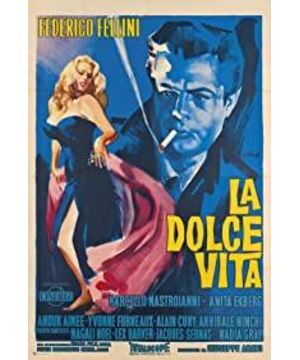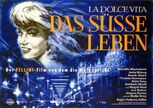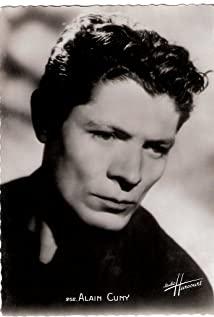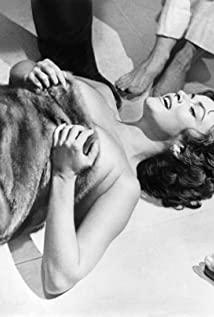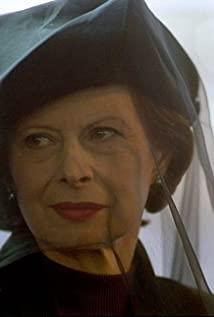In the nearly three-hour film, Fellini used the language of the lens to convey rich ideas, but his comprehension ability was insufficient, and he could only give himself a first glimpse of the master's door. The statue of Jesus hanged by an airplane at the beginning symbolizes traditional values dominated by Christianity, while a few bikini girls represent emerging capitalist consumer values. Marcello, as a reporter, did not follow the Jesus statue, but chatted up with the girl to illustrate the change in social values. The whole society stopped believing in various gods, but began to look up to the upper class society of the bourgeoisie. So Marcello asked to have sex with the rich second-generation Madeleine, who had a huge gap between rich and poor. When American actress Sylvia asked him to buy milk, he refused without hesitation. When Sylvia, a symbol of high society, got off the plane, some reporters had to lie on the ground to shoot. So she can easily climb the church, and others can't keep up with her pace, even Marcello, who has half a foot into the upper class, is a waste of strength. Let me talk about the identity of the male protagonist here, that is, a reporter and a writer. Journalism was his main breadwinner occupation, through which he could reach and enter high society and satisfy his vanity. But the male protagonist is different from those other reporters. He doesn't take pictures like the paparazzi. He records more and provides material for his book. The writer represented his dream, the best part of his heart, so he would envy the intellectual gathering of the Turners' house. After understanding the duality of the male protagonist, we can well understand his inner struggle and the conflict with his fiancee Emma. 1. Relentless mockery of reporters The reporters in the film are like flies everywhere, swarming with them from beginning to end. Candid shots of the prince and star Robbo; surrounded by Sylvia; paid the interviewee to pose for the photo; even the director went to restore the scene of the Advent of the Virgin and gave the interviewee the manuscript... It can be said that there is no professional ethics or even a moral bottom line. As Marcello said: what journalists write is entirely because of what readers want to see. Readers like exaggerated things, and reporters go to concoct exaggerated news. As long as you give the money unit, he can write you as anyone. It's no wonder that Fellini used the mouths of the people in the film to complain: Journalism will be over in '65. 2. The critique of religious belief begins with a famous shot where Marcello takes off his sunglasses and rips off the reporter's camouflage (similar shots include George in Cariglia Nights), and Sylvia's hat falls off and removes the upper class A symbol of society, the two asked the paparazzi to follow and came to a fountain full of statues, where Sylvia incarnates the Virgin to baptize Marcello. Maslow feels time stand still, but in the next shot he sees that it's all fake, and passers-by are looking at them strangely. Fellini denies religious beliefs through this classic lens. Then there were the two children who claimed to have seen the Virgin Mary and were caught by the police. The absurd scene of being released under the momentum of the crowd and the media, and taking everyone to Mass. Fellini used the lens of the priest's interview to tell us: miracles do not come easily, the two children are deceiving people, and the Virgin Mary is not seen at all. But as the old woman said: Italy is a country with a long religious history. People worship supernatural powers, feel the influence of religion, and believers get what they need. The believers got their spiritual solace, the media got a big news, and no one cared whether it was true or not. The last heavy rain seemed to be a real miracle from God, and the dead boy was a warning to believers of these false beliefs. 3. The conflict between family and dreams is first and foremost in the relationship with Emma. Emma is the male protagonist she really loves, and she is spiritually dependent on him, which is why she became a resentful woman alive. It can be seen from the fact that she did not believe in the miracle of the Advent of the Virgin Mary to shake the tree symbolizing the Virgin in order to pray for Marcello to marry him. And Marcello also loves Emma. When Emma passed out, Marcello showed concern and anxiety as a fiancé, although he also selfishly complained that Emma might be reported to affect his future by doing so. But she still called and asked her about the plot in her busy schedule, but Emma hadn't woken up at that time. The relationship between the two basically reflects the difference between the two sexes: Emma, as a woman, believes that as long as the two love each other, it is the greatest happiness. And Marcello believes that in addition to love, he has his own dreams, which is why he has never dared to get married. He said to Emma: I can't love only one person in my life, this sentence should be understood as I have to love other things. Because of this conflict, the two chose to separate. And because they fell in love with each other, they reunited in an instant. The second aspect is the male protagonist's inner struggle about family and dreams. When the male protagonist went to attend Tynas' house party, he said to Tynas: I envy his family's happiness, sweet life, and envy him for having a family and having many extraordinary friends. The family is a sanctuary, and although I am ambitious, I am not accomplishing anything. Tynas answered him: It is better to live a down and stable life, because everything has been arranged and there is no change. Later he also said: afraid of peace, we must abandon feelings, we must find harmony in artworks. We must learn to love each other and withdraw from life objectively. It can be seen from the recordings in the gramophone that he is a writer who yearns for nature. The tranquility of his family life makes him lose his creative inspiration, and he cannot stand this peaceful life. This is also the reason why he later killed two children and then committed suicide, the two children are symbols of this peaceful and sweet life. Tynas' words touched the male protagonist very much, and he began to pursue his dream. So in the next shot we see him writing in a restaurant, which is supposed to be the publisher feed he was going to introduce to Tynas, showing that he started chasing his dreams. The beautiful little girl begged him to teach her to type, and he said the little girl was like an angel. In addition to the fact that the little girl is really beautiful, the more important thing is that the little girl is connected with his dream writing and has become the most beautiful part of his heart. Later, the father of the male protagonist came to see him. This paragraph introduces us to the character of the male protagonist and the reasons for his psychological predicament. The male protagonist's romantic and social skills seem to be inherited from his father. But since he was a child, his father seldom came home because of his busy work, and he didn't even know his own father. This created his fear of starting a family, of repeating the mistakes of his childhood. In the end, he wanted to make up for his childhood regrets, repair the relationship between father and son, and wanted his father to stay for a few more days. He could provide the best hotel and ask for leave to accompany him. However, his father finally chose to leave because of his failure to revive his glory. In the end, the male protagonist's struggles with family and dreams were all corroded by the upper class, and all came to nothing. 4. The degeneration of the upper class This is the core idea of the film. There are mainly two episodes to show: the first one is in the prince's castle, everyone took candles to explore the castle, and some people played psychic games. Madeleine played a game of whispers with Marcello while flirting with other men. Marcello also had an affair with a lady in the castle. The second paragraph is in the villa of a divorced woman, and successively there are striptease, multiplayer sports, gay pseudo-girls, Marcello and a horse riding game of a prostitute. Fellini shows us the decadence and depravity of the bourgeois upper class society and the spiritual desert behind the materialism in two rather restrained plots. In the end, everyone walked to the beach in the emptiness after the carnival. A monster like an octopus was stranded there. Everyone didn't feel sick, but talked a lot. That monster is the embodiment of the spirit of the bourgeoisie, corrupt and dead. Marcello's angel - that little girl called to him, that was calling to him from the beauty in his heart, and it was his last salvation. But he couldn't hear any sound, and he had gradually lost himself in the high society's intoxication. So the last little girl could only stare at him with a smile, and then at us in front of the camera. Fellini then asked the little girl's beautiful eyes: Are you as depraved as they are? The two most common images in Fellini's films are the circus and the beach. The circus comes from his childhood experience, symbolizing the joy and beauty of childhood. And the beach seems to be a symbol of despair, such as in the road and the waves. These two images of Fellini seem to tell us that life is such a circus-like carnival, and after the carnival is over, only the despair of a lonely person on the beach remains. The degeneration of the upper class is the core idea of the film. There are mainly two episodes to show: the first one is in the prince's castle, everyone took candles to explore the castle, and some people played psychic games. Madeleine played a game of whispers with Marcello while flirting with other men. Marcello also had an affair with a lady in the castle. The second paragraph is in the villa of a divorced woman, and successively there are striptease, multiplayer sports, gay pseudo-girls, Marcello and a horse riding game of a prostitute. Fellini shows us the decadence and depravity of the bourgeois upper class society and the spiritual desert behind the materialism in two rather restrained plots. In the end, everyone walked to the beach in the emptiness after the carnival. A monster like an octopus was stranded there. Everyone didn't feel sick, but talked a lot. That monster is the embodiment of the spirit of the bourgeoisie, corrupt and dead. Marcello's angel - that little girl called to him, that was calling to him from the beauty in his heart, and it was his last salvation. But he couldn't hear any sound, and he had gradually lost himself in the high society's intoxication. So the last little girl could only stare at him with a smile, and then at us in front of the camera. Fellini then asked the little girl's beautiful eyes: Are you as depraved as they are? The two most common images in Fellini's films are the circus and the beach. The circus comes from his childhood experience, symbolizing the joy and beauty of childhood. And the beach seems to be a symbol of despair, such as in the road and the waves. These two images of Fellini seem to tell us that life is such a circus-like carnival, and after the carnival is over, only the despair of a lonely person on the beach remains. The degeneration of the upper class is the core idea of the film. There are mainly two episodes to show: the first one is in the prince's castle, everyone took candles to explore the castle, and some people played psychic games. Madeleine played a game of whispers with Marcello while flirting with other men. Marcello also had an affair with a lady in the castle. The second paragraph is in the villa of a divorced woman, and successively there are striptease, multiplayer sports, gay pseudo-girls, Marcello and a horse riding game of a prostitute. Fellini shows us the decadence and depravity of the bourgeois upper class society and the spiritual desert behind the materialism in two rather restrained plots. In the end, everyone walked to the beach in the emptiness after the carnival. A monster like an octopus was stranded there. Everyone didn't feel sick, but talked a lot. That monster is the embodiment of the spirit of the bourgeoisie, corrupt and dead. Marcello's angel - that little girl called to him, that was calling to him from the beauty in his heart, and it was his last salvation. But he couldn't hear any sound, and he had gradually lost himself in the high society's intoxication. So the last little girl could only stare at him with a smile, and then at us in front of the camera. Fellini then asked the little girl's beautiful eyes: Are you as depraved as they are? The two most common images in Fellini's films are the circus and the beach. The circus comes from his childhood experience, symbolizing the joy and beauty of childhood. And the beach seems to be a symbol of despair, such as in the road and the waves. These two images of Fellini seem to tell us that life is such a circus-like carnival, and after the carnival is over, only the despair of a lonely person on the beach remains. Staring at him with a smile, then at us in front of the camera. Fellini then asked the little girl's beautiful eyes: Are you as depraved as they are? The two most common images in Fellini's films are the circus and the beach. The circus comes from his childhood experience, symbolizing the joy and beauty of childhood. And the beach seems to be a symbol of despair, such as in the road and the waves. These two images of Fellini seem to tell us that life is such a circus-like carnival, and after the carnival is over, only the despair of a lonely person on the beach remains. Staring at him with a smile, then at us in front of the camera. Fellini then asked the little girl's beautiful eyes: Are you as depraved as they are? The two most common images in Fellini's films are the circus and the beach. The circus comes from his childhood experience, symbolizing the joy and beauty of childhood. And the beach seems to be a symbol of despair, such as in the road and the waves. These two images of Fellini seem to tell us that life is such a circus-like carnival, and after the carnival is over, only the despair of a lonely person on the beach remains.
View more about The Sweet Life reviews


